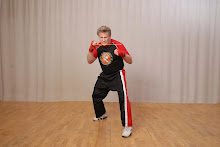A recent question;
Mr. Lewis, fighters intuitively/instinctively shake their arms/legs during a fight to release lactic acid. What are some ADDITIONAL things one could do besides shaking arms/legs to release lactic acid?
This is a great question all trainers need to be able to answer. Since I do not have a degree in exercise physiology, let’s not get into an unnecessary discussion of any lactic acid hypothesis on a molecular level. To keep what is important in focus, initially there are three factors all anaerobic or aerobic athletes (particularly fighters) who compete need to understand. You must know how to relax and also how to pace yourself. The third asset is being able to maintain the right mind-set; that is how to remain determined----never yielding the perseverance of effort to remain engaged.
“I never even think about quitting; next to dying, it's the last thing I'd ever do.”
A number of fighters believe that lactic acid gets released during hard sparring or strained, unaccustomed exercise drills and that this diminishes one’s performance while also causing soreness and residual stiffness. First of all, lactic acid does not exist as an acid in the body; it exists in another form called “lactate.” Lactic acid will be gone from your muscles within an hour of exercise and the stiffness sets in one to three days later. Most of the stiffness in muscles is due to muscle damage from the exercise and other factors.
For a more technical understanding of the “Lactic Acid” phenomena check out the following link.
Your muscle cells convert glucose or glycogen to lactic acid. These cells have “energy assimilators,” called mitochondria that use the lactic acid for fuel. Real intense training, like a body-builder doing a lifting exercise to failure, can make double the mitochondrial mass. The theory here has evolved by coaches and trainers realizing that by increasing the muscle mitochondria, allowing for greater efficiency in burning of lactic acid, that athletic performance improved.
“Shaking of the arms/legs” may seem like a way to release lactic acid buildup; however, logic would tell one that the effort to do such movements may only produce more lactic acid. Such a circumstance---wondering what to do once the lactic acid buildup reaches this point---is like asking what does a combat unit do on the battlefield once they run out of ammunition.
Some tips from field experience:
Some tips from field experience:
- Just before a race or bout, train very hard with a few brief sprints or sparring combinations.
- Maintain proper hydration of the body, paying attention to the balance of your sodium and potassium levels.
- Digest some bicarbonate fluids prior to hard exercise like fighting.
- Learn how to use your “core” muscle groups instead of your multi-joint muscles for certain skills. Example: When doing a rear naked choke, try to completely relax your arms from the shoulders to your wrists. Instead of squeezing with arm strength, only use your core and back muscles for pulling----the lats, the posterior deltoids, the lower trapeziums, and hunching your pelvic diaphragm upwards.
- Flip flop muscle usage----when arm wrestling, learn to switch between using only the forearm muscles for a brief segment while relaxing the upper arm, and then switch that part of the arm you are using with the other. Breath control is critical here as part of this technique. I’ve seen guys who could be extremely hard externally and completely relaxed internally---and then switch in a split second.
- As you approach your pain threshold, practice maintaining full effort to bust through it occasionally, or learn to find your rhythm as to when to back off and for how long before you reengage. Learning to control your rhythm builds inner confidence. A runner may drag behind to trail another runner in order to regroup. A fighter or arm wrestler may relax for a round or for a minute or two and just play defense allowing his opponent to offensively burn out.
- Lastly, again, let us not forget the overall importance of the balanced conditioning of one’s attitude and body---that both can be affected by many factors. Lactic acid is a by-product of hard exercise; however, well-conditioned athletes are better able to recycle it back through the liver for energy. This is why their performance is not as limited by a buildup of lactic acid.
http://en.wikipedia.org/wiki/Lactic_acid
http://www.nytimes.com/2006/05/16/health/nutrition/16run.html?_r=1
